
Brassicaceae or Cruciferae is a medium-sized and economically important family of flowering plants commonly known as the mustards, the crucifers, or the cabbage family. Most are herbaceous plants, some shrubs, with simple, although sometimes deeply incised, alternatingly set leaves without stipules or in leaf rosettes, with terminal inflorescences without bracts, containing flowers with four free sepals, four free alternating petals, two short and four longer free stamens, and a fruit with seeds in rows, divided by a thin wall.
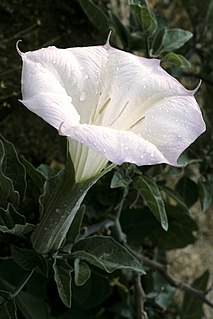
Datura is a genus of nine species of poisonous vespertine flowering plants belonging to the family Solanaceae. They are commonly known as thornapples or jimsonweeds but are also known as devil's trumpets. Other English common names include moonflower, devil's weed and hell's bells. All species of Datura are poisonous and potentially psychoactive, especially their seeds and flowers which can cause respiratory depression, arrhythmias, fever, delirium, hallucinations, psychosis, and even death if taken internally. Due to its effects and symptoms, it has occasionally been used not only as a poison, but also as a hallucinogen by various groups throughout history. Traditionally, psychoactive administration of daturas has often been associated with witchcraft and sorcery or similar practices in many cultures, including the Western world. Certain common datura species have also been used ritualistically as entheogens by some Native American groups. Non-psychoactive use of the plant is usually done for medicinal purposes and the alkaloids present in plants of the datura genus have long been considered traditional medicines in both the New and Old Worlds due to the presence of the alkaloids scopolamine and atropine, which are also produced by Old World plants such as hyoscyamus niger, atropa belladonna and mandragora officinarum.

Eschscholzia californica, the California poppy, golden poppy, California sunlight or cup of gold, is a species of flowering plant in the family Papaveraceae, native to the United States and Mexico. It is cultivated as an ornamental plant flowering in summer, with showy cup-shaped flowers in brilliant shades of red, orange and yellow. It is also used as food or a garnish. It became the official state flower of California in 1903.

The radish is an edible root vegetable of the family Brassicaceae that was domesticated in Asia prior to Roman times.

Matthiola, is a genus of flowering plants in the mustard family Brassicaceae. It was named after the Italian naturalist Pietro Andrea Mattioli (1501-1577). This genus contains about 48 to 50 species of annual, biennial and perennial herbaceous plants and subshrubs. Many are cultivated for their heavily scented, colorful flowers.

Lomatia tasmanica, commonly known as King's lomatia, is a shrub of the family Proteaceae native to Tasmania. Growing up to 8 metres (26 ft) tall, the plant has shiny green pinnate (lobed) leaves and bears red flowers in the summer, but yields neither fruit nor seeds. King's lomatia is unusual because all of the remaining plants are genetically identical clones. Because it has three sets of chromosomes and is therefore sterile, reproduction occurs only vegetatively: when a branch falls, that branch grows new roots, establishing a new plant that is genetically identical to its parent.
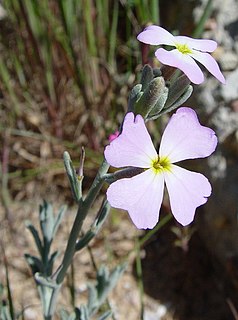
Malcolmia is a genus of flowering plants from the family Brassicaceae. Species from this genus are native to Europe and Africa.
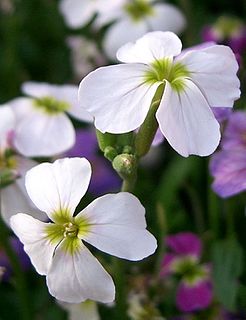
Malcolmia maritima, also known by its common name Virginia stock, is a popular annual garden plant from the family Brassicaceae. A beautiful and profusely flowering annual, it is probably one of the easiest of all plants to grow. Growing to about 6–12 inches tall, it makes a mass of pink, purple and white fragrant four petalled (cruciform) flowers. It is native in Greece and Albania and may be naturalized elsewhere in Mediterranean Europe where it occurs in maritime sandy habitats and in waste places.

Banksia acanthopoda is a species of shrub in the family Proteaceae. It grows as a small spreading shrub to 2 m high and has prickly leaves and yellow composite flower heads, called inflorescences, composed of 50 to 60 individual yellow flowers. Flowering takes place in the southern hemisphere winter. Endemic to Western Australia, it occurs only in a few populations in the vicinities of Woodanilling, Katanning and Darkan. Because of its rarity, it is classed as "Priority Two" conservation flora by Western Australia's Department of Environment and Conservation.
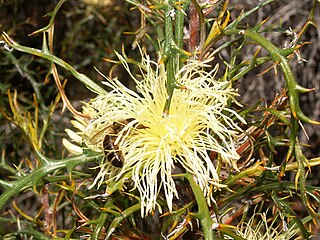
Banksia wonganensis is a large shrub endemic to Western Australia that, until 2007, was previously known as Dryandra wonganensis. It occurs within a small area in the vicinity of the Wongan Hills. It grows on lateritic soils in open woodland or amongst dense shrub. It is rare, but does not appear to be endangered.

A weed is a plant considered undesirable in a particular situation, "a plant in the wrong place". Examples commonly are plants unwanted in human-controlled settings, such as farm fields, gardens, lawns, and parks. Taxonomically, the term "weed" has no botanical significance, because a plant that is a weed in one context is not a weed when growing in a situation where it is in fact wanted, and where one species of plant is a valuable crop plant, another species in the same genus might be a serious weed, such as a wild bramble growing among cultivated loganberries. In the same way, volunteer crops (plants) are regarded as weeds in a subsequent crop. Many plants that people widely regard as weeds also are intentionally grown in gardens and other cultivated settings, in which case they are sometimes called beneficial weeds. The term weed also is applied to any plant that grows or reproduces aggressively, or is invasive outside its native habitat. More broadly "weed" occasionally is applied pejoratively to species outside the plant kingdom, species that can survive in diverse environments and reproduce quickly; in this sense it has even been applied to humans.

Watermelon is a flowering plant species of the Cucurbitaceae family. A scrambling and trailing vine-like plant, it was originally domesticated in Africa. It is a highly cultivated fruit worldwide, with more than 1,000 varieties.

The Eastern Anatolian deciduous forests ecoregion is located in the mountains of eastern Turkey. It is a Palearctic ecoregion in the temperate broadleaf and mixed forests biome.

Leucospermum praemorsum is an evergreen shrub or small tree of up to 5 m (16 ft) high. It has hairless oblong to inverted lance-shaped leaves of 7–8 cm long and 1½–2 cm wide, tapering at their base to a stalk of up to 2 cm long, and cut-off at the tip with three to five teeth, and pale carmine, inverted cone-shaped flower heads. From the center of the flowers emerge long initially orange, later deep crimson styles that jointly give the impression of a pincushion. It is called Nardouw fountain-pincushion or Nardouw pincushion in English and Nardouwluisiesbos in Afrikaans. Flower heads can be found off and on throughout the year, particularly in older plants, with a peak between July and December. It is an endemic species that can only be found in part of the Western Cape province of South Africa.
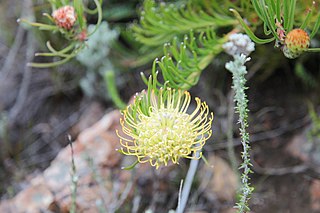
Leucospermum lineare is an evergreen shrub with linear leaves and is assigned to the Proteaceae. There are two distinct forms that have not been formally recognized as separate taxa. There is an upright form with orange flower heads of up to 2 m (6.6 ft) high, and a sprawling form of 2–3 m (6.6–9.8 ft) in diameter with yellow flower heads. Its common name is needle-leaf pincushion, or narrow-leaf pincushion, in English and smalblaarspeldekussing in Afrikaans. The orange-flowered form is called tangerine pincushion or assegaaibos pincushion. Flowering occurs in the first half of the southern hemisphere season, but peaks in September and October. It is an endemic species that can only be found in the southwest of the Western Cape province of South Africa.

Leucospermum grandiflorum is an evergreen, upright shrub of up to 2½ m high that is assigned to the family Proteaceae. It has elliptic, greyish green, softly hairy leaves and initially egg-shaped heads with yellow flowers, later flatter with flowers turning orange. From the center of each flower emerges a long pale yellow style with a pink thickened tip that is bent slightly clockwise, giving the entire head the appearance of a pincushion. Its flowers can be found between July and December. It is called grey-leaf fountain-pincushion or rainbow pincushion in English. L. grandiflorum is an endemic species that can only be found in nature in the Western Cape province of South Africa.
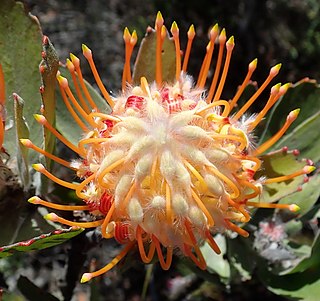
Leucospermum pluridens is a large upright evergreen shrub of up to 3 m (10 ft) high assigned to the family Proteaceae. It has leathery, oblong to wedge-shaped leaves of about 7½ cm long and 2½ cm wide, deeply incised near the tip with seven to ten teeth. It has initially yellow, later carmine coloured flower heads. The 2 cm long bracts have slender, recurved tips. From the center of the perianth emerge long styles that jointly give the impression of a pincushion. It is called Robinson pincushion in English and Robinson-kreupelhout in Afrikaans. Flowers can be found between September and December. It naturally occurs in the south of South Africa.

Leucospermum wittebergense is an evergreen, upright to more or less spreading shrub of ½–1½ m (1⅔–5 ft) high and wide from the family Proteaceae. It has globe-shaped flower heads of about 2 cm (0.8 in) in diameter with initially whitish, later pinkish flowers. It has crowded, overlapping, inverted lance-shaped leaves, set at an upward angle and covered in short, dense grey-silvery shaggy hairs. From the center of the perianth emerge almost straight styles that jointly give the impression of a pincushion. It is called Swartberg pincushion in English. The species naturally occurs in the Western Cape province of South Africa. It can be found flowering between August and January.

Leucospermum secundifolium is a low, evergreen shrub that grows along the ground, the tip of the branches slightly rising, which ihs been assigned to the family Proteaceae. It has narrowly elliptic leaves with a distinct leafstalk, and few-flowered and very small heads of 1–1½ cm (0.4–0.6 in) across. It is called stalked pincushion in English. The sweetly scented flower heads may be found around early December. It is an endemic species that only grows in a small area of the Western Cape province of South-Africa.
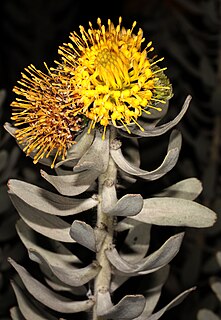
Leucospermum rodolentum is an upright, evergreen shrub of up to 3.0 m high, from the family Proteaceae. It has felty grey, elliptic to wedge-shaped leaves of 4–6½ cm (1.8–2.6 in) long and ¾–1½ cm wide, and very sweetly scented, globe-shaped, 3–3½ cm (1.2–1.4 in) wide, bright yellow flower heads, that are seated or on a very short stalk of ½ cm long, grouped with two to four together. Its common names include is sandveld pincushion in English and sandluisie or sandveldluisiesbos in Afrikaans. The plants are in bloom between August and November. It is an endemic species that only grows in a small area of the Western Cape province of South-Africa.




















